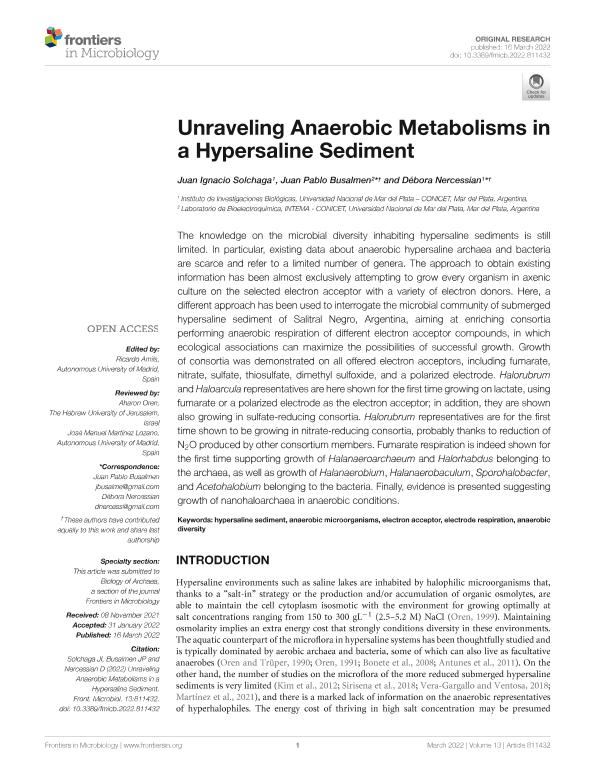Mostrar el registro sencillo del ítem
dc.contributor.author
Solchaga, Juan Ignacio

dc.contributor.author
Busalmen, Juan Pablo

dc.contributor.author
Nercessian, Debora

dc.date.available
2023-09-27T15:50:33Z
dc.date.issued
2022-01
dc.identifier.citation
Solchaga, Juan Ignacio; Busalmen, Juan Pablo; Nercessian, Debora; Unravelling anaerobic metabolisms in hypersaline sediment; Frontiers Media; Frontiers in Microbiology; 13; 1-2022; 1-15
dc.identifier.issn
1664-302X
dc.identifier.uri
http://hdl.handle.net/11336/213267
dc.description.abstract
The knowledge on the microbial diversity inhabiting hypersaline sediments is still limited. In particular, existing data about anaerobic hypersaline archaea and bacteria are scarce and refer to a limited number of genera. The approach to obtain existing information has been almost exclusively attempting to grow every organism in axenic culture on the selected electron acceptor with a variety of electron donors. Here, a different approach has been used to interrogate the microbial community of submerged hypersaline sediment of Salitral Negro, Argentina, aiming at enriching consortia performing anaerobic respiration of different electron acceptor compounds, in which ecological associations can maximize the possibilities of successful growth. Growth of consortia was demonstrated on all offered electron acceptors, including fumarate, nitrate, sulfate, thiosulfate, dimethyl sulfoxide, and a polarized electrode. Halorubrum and Haloarcula representatives are here shown for the first time growing on lactate, using fumarate or a polarized electrode as the electron acceptor; in addition, they are shown also growing in sulfate-reducing consortia. Halorubrum representatives are for the first time shown to be growing in nitrate-reducing consortia, probably thanks to reduction of N2O produced by other consortium members. Fumarate respiration is indeed shown for the first time supporting growth of Halanaeroarchaeum and Halorhabdus belonging to the archaea, as well as growth of Halanaerobium, Halanaerobaculum, Sporohalobacter, and Acetohalobium belonging to the bacteria. Finally, evidence is presented suggesting growth of nanohaloarchaea in anaerobic conditions.
dc.format
application/pdf
dc.language.iso
eng
dc.publisher
Frontiers Media

dc.rights
info:eu-repo/semantics/openAccess
dc.rights.uri
https://creativecommons.org/licenses/by-nc-sa/2.5/ar/
dc.subject
ANAEROBIC DIVERSITY
dc.subject
ANAEROBIC MICROORGANISMS
dc.subject
ELECTRODE RESPIRATION
dc.subject
ELECTRON ACCEPTOR
dc.subject
HYPERSALINE SEDIMENT
dc.subject.classification
Biología Celular, Microbiología

dc.subject.classification
Ciencias Biológicas

dc.subject.classification
CIENCIAS NATURALES Y EXACTAS

dc.title
Unravelling anaerobic metabolisms in hypersaline sediment
dc.type
info:eu-repo/semantics/article
dc.type
info:ar-repo/semantics/artículo
dc.type
info:eu-repo/semantics/publishedVersion
dc.date.updated
2023-07-06T11:46:15Z
dc.journal.volume
13
dc.journal.pagination
1-15
dc.journal.pais
Suiza

dc.description.fil
Fil: Solchaga, Juan Ignacio. Consejo Nacional de Investigaciones Científicas y Técnicas. Centro Científico Tecnológico Conicet - Mar del Plata. Instituto de Investigaciones Biológicas. Universidad Nacional de Mar del Plata. Facultad de Ciencias Exactas y Naturales. Instituto de Investigaciones Biológicas; Argentina
dc.description.fil
Fil: Busalmen, Juan Pablo. Consejo Nacional de Investigaciones Científicas y Técnicas. Centro Científico Tecnológico Conicet - Mar del Plata. Instituto de Investigaciones en Ciencia y Tecnología de Materiales. Universidad Nacional de Mar del Plata. Facultad de Ingeniería. Instituto de Investigaciones en Ciencia y Tecnología de Materiales; Argentina
dc.description.fil
Fil: Nercessian, Debora. Consejo Nacional de Investigaciones Científicas y Técnicas. Centro Científico Tecnológico Conicet - Mar del Plata. Instituto de Investigaciones Biológicas. Universidad Nacional de Mar del Plata. Facultad de Ciencias Exactas y Naturales. Instituto de Investigaciones Biológicas; Argentina
dc.journal.title
Frontiers in Microbiology
dc.relation.alternativeid
info:eu-repo/semantics/altIdentifier/url/https://www.frontiersin.org/articles/10.3389/fmicb.2022.811432/full
dc.relation.alternativeid
info:eu-repo/semantics/altIdentifier/doi/https://doi.org/10.3389/fmicb.2022.811432
Archivos asociados
